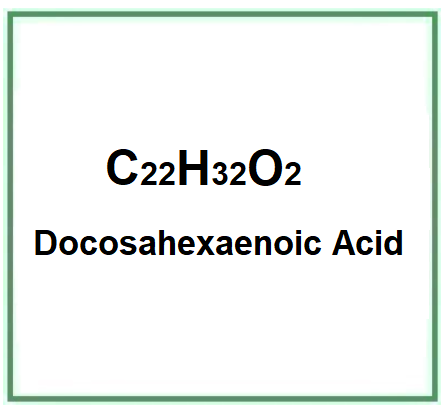Docosahexaenoic acid or DHA is a neutrophic and neuroprotective fatty acid, primary in mitochondrial phospholipid skeletal muscles.
The name describes the structure of the molecule:
- "Docosa-" is derived from the Greek word for 22, indicating that the molecule has 22 carbon atoms.
- "-hexaenoic" indicates that there are six double bonds in the molecule.
- "Acid" refers to the presence of a carboxylic acid group (-COOH) in the molecule.
The synthesis of DHA in nature typically involves the elongation and desaturation of alpha-linolenic acid (ALA), a shorter-chain omega-3 fatty acid. Here is a simplified version of the process:
- ALA is first desaturated by the enzyme delta-6-desaturase to produce stearidonic acid.
- Stearidonic acid is then elongated to produce eicosatetraenoic acid.
- Eicosatetraenoic acid is desaturated again to produce eicosapentaenoic acid (EPA).
- EPA is elongated to produce docosapentaenoic acid.
- Finally, docosapentaenoic acid is desaturated to produce DHA.
It appears as a yellow liquid.

What it is for and where
In the human body docosahexaenoic acid can influence neurological function by modulating:
- neurotransmission
- neurogenesis
- myelination
- synaptic plasticity
- neuroinflammation
- membrane integrity
membrane organization
DHA is rapidly accumulated in the brain during gestation and early childhood. The consumption of DHA leads to many positive physiological and behavioral effects, including those on cognition. Cognitive changes throughout the life span correspond to the development, maturation and aging of the brain. The brain is an organ rich in lipids that consumes 20% of the body's energy, but includes only 2% of the body's mass. Quantitatively, docosahexaenoic acid (DHA; 22: 6 n -3) is the most significant n -3 PUFA in the brain while both eicosapentaenoic acid (EPA; 20: 5 n -3) and alpha-linolenic acid ( ALA; 18: 3 n -3) are present only in very small quantities (1).
Docosahexaenoic acid (DHA) is maintained and concentrated solely in the nervous system, particularly in photoreceptors and in synaptic membranes. DHA plays a key role in vision, neuroprotection, aging, memory and other functions (2).
Medical
- Neurology. DHA is crucial for brain health. It is one of the main structural components of neurons in our brain and is important for both the development and functioning of the brain throughout life.
- Psychiatry. DHA has proven useful in the treatment of major depressive disorder. It has the potential to improve the brain's responses to emotional stimuli.
- Ophthalmology. DHA is an important structural component of the retina of the eye. It is needed to maintain normal retinal function.
- Cardiovascular system. DHA helps reduce inflammation and improve cardiovascular function.
- Spinal cord. Research has shown that DHA can contribute to neuroprotection and promote neuroplasticity after spinal cord injury.
- Oncology. DHA is being studied for its potential use in the treatment of cancer. It has been used in combination with other drugs to improve the efficacy of cancer therapies.
Cosmetics
Antistatic agent. Static electricity build-up has a direct influence on products and causes electrostatic adsorption. The antistatic ingredient reduces static build-up and surface resistivity on the surface of the skin and hair.
Skin conditioning agent. It is the mainstay of topical skin treatment as it has the function of restoring, increasing or improving skin tolerance to external factors, including melanocyte tolerance. The most important function of the conditioning agent is to prevent skin dehydration, but the subject is rather complex and involves emollients and humectants that can be added in the formulation.
Skin health. DHA is often used in skin care products due to its anti-inflammatory properties. It can help reduce skin inflammation and the effects of ageing.
Tanning products. DHA is the active ingredient in most sunless tanning products. It interacts with the dead surface cells of the epidermis to darken skin colour and simulate a tan.
Docosahexaenoic acid studies
Molecular Formula C22H32O2
Molecular Weight 328.5 g/mol
CAS 25167-62-8
References______________________________________________________________________
(1) Michael J. Weiser, Christopher M. Butt, M. Hasan Mohajeri Docosahexaenoic Acid and Cognition throughout the Lifespan Michael J. Weiser, Christopher M. Butt, M. Hasan Mohajeri
Nutrients. 2016 Feb; 8(2): 99. Published online 2016 Feb 17. doi: 10.3390/nu8020099
(2) Nicolas G. Bazan, Miguel F. Molina, William C. Gordon Docosahexaenoic Acid Signalolipidomics in Nutrition: Significance in Aging, Neuroinflammation, Macular Degeneration, Alzheimer’s, and Other Neurodegenerative Diseases Annu Rev Nutr. Author manuscript; available in PMC 2012 Jul 27. Published in final edited form as: Annu Rev Nutr. 2011 Aug 21; 31: 321–351. doi: 10.1146/annurev.nutr.012809.104635
![]() Docosahexanoic acid
Docosahexanoic acid 






